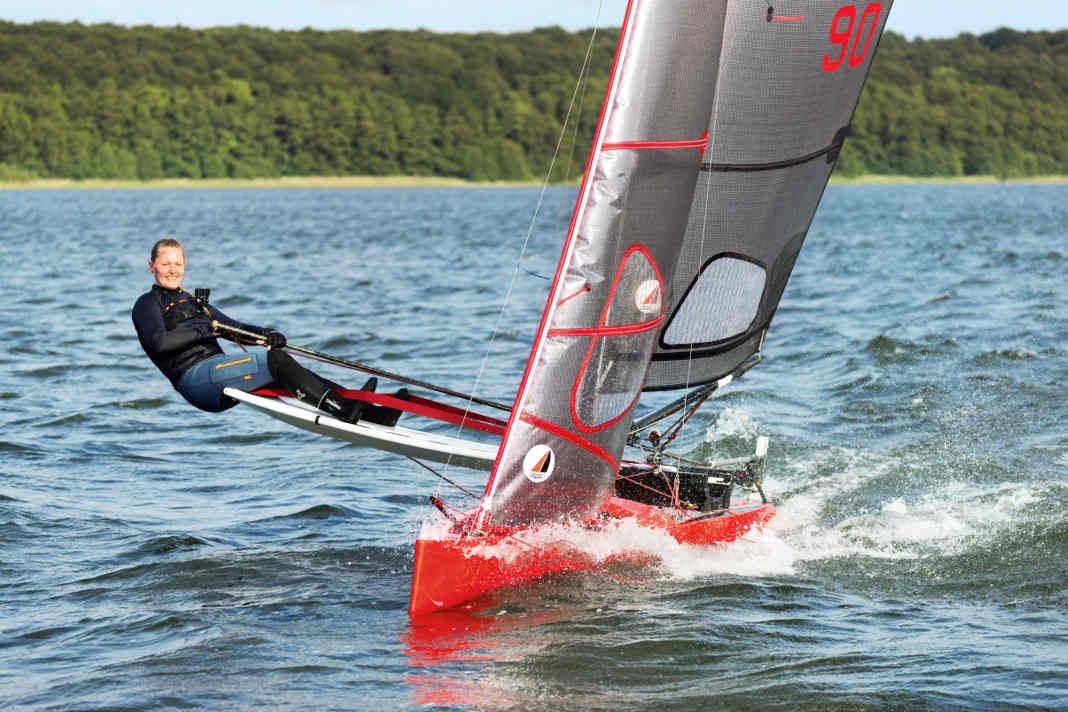





The light breeze on Lake Ratzeburg makes the water rustle beneath me and I hold the long tiller boom tightly in my hand. In the corner of my eye, I see a gust approaching and parry it with confidence. I'm now sitting almost two metres away from my hull and the shore is approaching menacingly fast. "How do I get this thing round the corner now? And, above all, how do I get to the new side myself?" I rattle around in my head. I'm sitting on one of the comparatively tame classic International Canoes (IC) from 1972.
Today's ultra-modern racing dinghies were once developed in England from the usual paddle canoes. Even today, the sailors are organised in the Canoe and Sailing Association. "The history of the IC began back in the 1860s," explains Eckhardt "Ecki" Pagel, who discovered canoeing for himself over 37 years ago. In order to be able to cover greater distances, attempts were made to equip the canoes with sails. A short time later, however, the focus was no longer purely on utility. "I have a newspaper page from 1883 at home that reports on a regatta in London on the Thames," says the 67-year-old.
Also interesting:
At that time, however, they usually still had a mizzen sail, but without today's characteristic outrigger board. This first appeared in 1886, but was initially banned again. Today, it makes the IC probably the fastest non-foiling single-handed dinghy. At speeds of up to 25 knots, you can whizz over the gliding water at a pleasantly airy height. A feeling that is otherwise only known from foilers such as the Motte.
The only difference is that you sit a full two metres away from the centre of the boat if the riding beam is extended to the maximum. The righting moment is then around 50 per cent higher than that of a foresailor in the trapeze. This is the only way to tame the sail area, which is limited to ten square metres. The sporty dinghy has an extremely small ratio of length to displacement and wetted area. Today's designs are 5.20 metres long, just 75 centimetres wide and weigh 50 kilograms when rigged. This results in a high hull speed. However, with its flat hull and tapered canoe stern, the IC is also characterised by excellent gliding properties.
At that time, after 37 years of one-design hulls, the IC became an open construction class again. The adopted box rule was clearly aimed at the construction of more radical boats made from ultra-modern materials. The latter are perhaps the biggest difference between the two sub-classes of the IC, explains Eckhardt Pagel. "When you work practically with aircraft construction technology, you naturally achieve an extremely low weight. This means that the latest designs travel almost twice as fast as the old canoes."
The requirements for sailors have hardly changed. Only a good sense of balance is even more important on the narrow sports equipment. Even the cost-intensive high-tech materials - all new hulls are made of carbon fibre - have had no noticeable effect on the class. "These are all the tinkerers and inventors who were there before."
The majority of IC sailors still build and tinker with their own boats. There are few to no standardised boats. Instead, hardly any design is the same as another. "There are a few that are the same. But each one has its own settings and special features," explains Emma Grigull. "Very few boats are actually built by professional boat builders. Instead, people learn how to build boats in this small area. I don't know anyone, at least in Germany, who gives everything away."
Grigull is Head of Canoe Sailing at the German Canoe Association. The sailor from Flensburg came to the IC via another sailing canoe, the Taifun. While the IC is an international class that is used in more than ten countries, Taifuns are sailed single-handed at national level and double-handed as a youth boat class. Unlike the IC, there are small outrigger boards on both sides of the not-so-narrow hull, but these cannot be moved.
Riding beam system: actually like a drawer in a chest of drawers
At the age of 19, the Taifun must be sailed alone, which requires certain physical requirements. It's different in the IC. This is one of the reasons why Grigull switched classes back then. "We are gender-neutral and we all sail together. It depends on the sailor sitting on the boat and not on height, weight, male, female or anything else."
The manoeuvres are particularly crucial and, above all, extremely demanding in terms of coordination. On the cross, the dinghy can still be steered in a relaxed position from the riding beam, but when tacking and jibing, it really gets down to business. During the manoeuvre, the riding board must be thrown to the new side. To do this, the sailor first slides slightly towards the boat and steers into the tack or jibe. As the manoeuvre progresses, the outrigger board is pushed to the new side with a lot of momentum. The new course should then be reached and, depending on the conditions, the sailor throws himself onto the board just as powerfully.
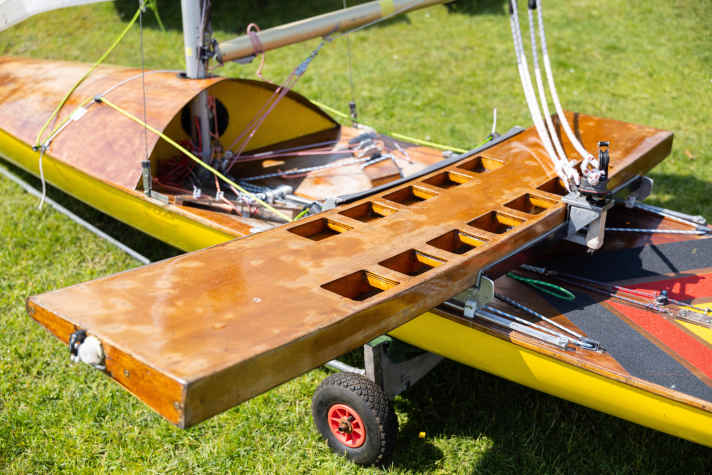
This then locks again automatically. This is because the ingenious system does not require any clamps or bolts. The seat tilts in its guide under the load and can be easily moved again without any load. Eckhardt Pagel confirms this: "The system actually works like a drawer in a chest of drawers. There's no technology in it. You don't have to fix or release anything."
The alignment in the direction of travel is different. The entire seat can be moved forwards or backwards on a rail and fixed depending on the conditions and course.
Foils on sailing canoes: decisive development for the World Championships in Travemünde?
The latest development has had a significant influence on this trim element. This is because a loophole has been found in the current regulations that allows foils to be attached to the rudder of the canoe. Although this cannot and must not lift the boat completely out of the water, it serves as an elevator. This eliminates weight and moves the centre of gravity further forward. This has already proven to be particularly useful on rough courses.
"What is only just starting in Germany is already more widespread in England," explains Emma Grigull. A strong dialogue between sailors is driving such innovations forward and is now also bringing them to Germany. Whether the ICs will always sail with foils from now on, however, is far from certain. "Someone always starts, and then the others realise what an advantage it brings, and then they join in. Or you realise that the development doesn't make sense and then you dismantle it again."
Grigull also recently completely rebuilt the rudder system on its approximately ten-year-old IC. As was previously customary, her rudder blade was recessed into the aft deck. Now it sits at the very back of the stern, as is usual for dinghies. This means the boat loses some agility, but saves the complicated rudder mechanism and allows the use of the rudder foil. This is because the class rules stipulate that the rudder blade must be fully retractable. With a simple plug-in system, as is common in many skiff classes, this is no problem.
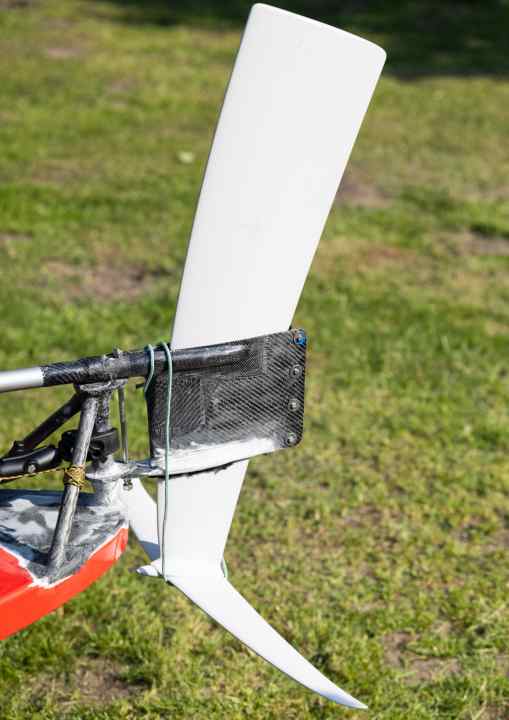
The wing is attached to the underside of the rudder blade, forming a classic T-foil. As with the Motte, the angle of inclination of the entire rudder can be changed by turning the tiller arm.
The Foil Grigulls IC canoe is surprisingly large, especially compared to the profiles commonly used in fully foiling boat classes. It therefore provides strong buoyancy, but also a lot more resistance due to the system. It is possible that this could pick up speed in the future if boats are built with a rudder foil clearly in mind. These would then potentially carry more volume in the foredeck and thus prevent nose dives.
Like a family: living together in the IC class
While the bright red hull of the "Wild Venture" cuts through the waves on the wind without any problems, sailing on the space wind corridors is a tippy affair, even for expert Emma Grigull. This has now been taken to the extreme with an IC spin-off with a gennaker. The so-called AC has an extremely high speed potential, but is almost impossible to control depending on the conditions. In some regattas, they are still represented in their own small starting group, but in general this innovation has not been able to establish itself.
"Development always continues somewhere, and it has to continue for the ICs too," says Eckhardt Pagel, who is also a passionate ice and beach sailor. "But my own wish for the class is that it continues to exist and that many younger people join again."
Due to the huge competition from many other classes, it is very difficult to recruit new talent these days. "There are classes that are expanding without end, partly due to people who might have got on the IC in the past," Pagel surmises. The high speeds and the special feeling of travelling, which cannot be compared with trapeze sailing, should be reason enough to get on the narrow projectile.
What Pagel finds really special, however, is living together in the class. "It's actually like a huge family. Everyone is extremely welcoming, whether you're in England, Australia or America." The veteran from Buchholz on Lake Ratzeburg should know, as Pagel has not missed any of the world championships, which are usually held every three years, since 1987.
The next one starts on 19 July as part of the Travemünde Week. The field of 34 sailing canoes registered so far will also include classic ICs, with the oldest design dating back to 1972. While Pagel will be on site as a surveyor and will therefore only be observing the events, this will be Emma Grigull's second world championship: "I'm really looking forward to the world championship and have the ambition to do everything I can!"
Technical data of the International Canoe
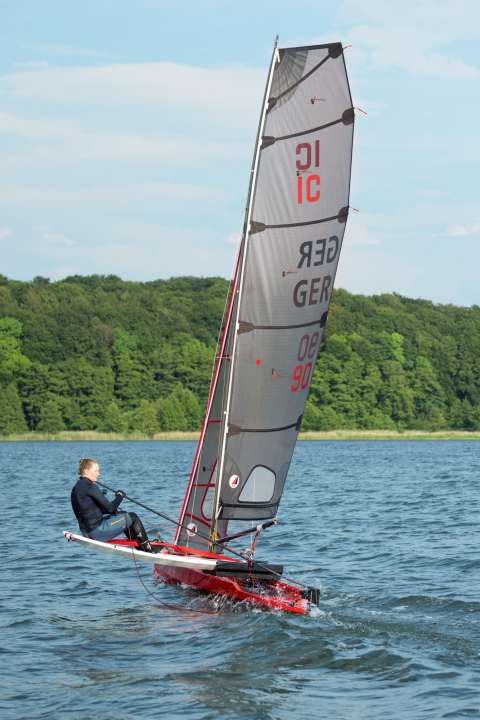
- Manufacturer: C12
- Total length: 5,20 m
- Width: 0,87 m
- Draught (sword): 1,00 m
- Mast height above lower edge of hull: 6,36 m
- Weight: 55 kg
- Mainsail: 7,53 m²
- Foresail: 2,47 m²
Classic ICs: traditionally fast
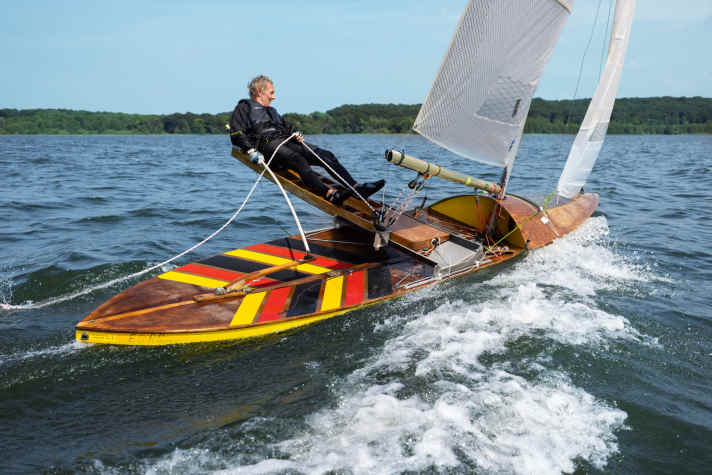
The Scottish travel writer John MacGregor, one of the forefathers of canoeing in Europe, is also said to be responsible for the first sails on the narrow hulls. The canoes, which were initially rigged for purely functional purposes, were continuously improved and became true racing dinghies at the latest with the reintroduction of the riding beam. In 1934, standardised international class rules were introduced for the first time. The IC pictured here is over 50 years old and will be the oldest boat with owner Klaus Röpke at the start of the upcoming world championship off Travemünde. The oldest trophy in sailing after the America's Cup will also be sailed there: the New York Canoe Club Challenge Trophy, which was first organised in 1886.
The yellow sailing canoe with the painted piranha teeth falls into the category of One Designs, which were common from 1971 to 2007. Although they were fast, they were significantly slower than today's standard for various reasons. For example, the minimum weight of 83 kilograms was significantly higher, and the ICs of the time were also wider. While even the slightly curved outrigger boards were made of wood in an elaborate process, today carbon fibre is used for the most part. The changes to the rig were minor, but the rudder system is remarkable. This was embedded in the stern with a cassette and is secured by a latch.
During tiller activity, only the rudder blade moves underneath the hull, as on a yacht, while the bracket is fixed in the deck. This allowed the rudder to be moved forwards, and the dinghy remains optimally manoeuvrable despite the long stern. Just like the system and the rough dimensions of the outrigger, this has been maintained to the end. However, today's outrigger seats are much easier to move during manoeuvres. Today's widely used self-tacking jibs also help enormously when tacking and gybing.
Interview with IC veteran Eckhardt Pagel
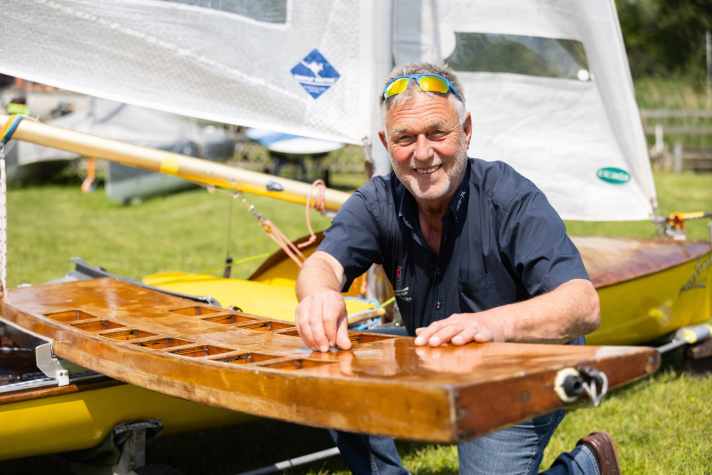
YACHT: How did you get into IC sailing?
Eckhardt Pagel: As a teenager, I saw an IC on display at the boat show in Hamburg. Back then, I decided to buy one when I had time and money. There came a point when I had time but no money - and I bought an IC anyway.
So did you later build sailing canoes yourself for financial reasons?
I built three boats myself, not just for the money, but also to be able to sail a boat that suited me. I always used the one that promised to work best. The last boat was extremely light and way ahead of its time.
To what extent have modern materials changed the classroom?
In the past, buildings were made of fibreglass. It wasn't as complex and was also cheaper than today. However, people are more important than the material. Nothing has changed in that respect. I would even say that every boat class is sailed by a certain type of person. In my experience, the ICs are very likeable people.
You have travelled all over the world. Which success remains particularly memorable to this day?
The 2008 World Championships in Australia. I came eleventh there.

